How technology is defining the ground rules of leadership 2.0
Powered by the ever-changing dynamics of globalisation and technology, our lives have undergone a tectonic shift. From what we do and feel to how we live has come to be dominated by technology. It has made a massive impact on business – affecting how we build, work, and interpret things as well as how we engage, associate, and lead.
In other words, the workplace is no longer what it was. The way leaders have to handle the changes brought about by the evolving economy and the acceleration in technology has pushed us to confront and redefine how we look at work and its future.

The future of work demands that we redefine leadership. There is an ongoing transition from traditional models of management to methods that accommodate millennials and Generation Z. Organisations are seeing a wave of change in decision making through a different approach to sustainable leadership. They are accepting value-based leadership to create an impact that fosters innovation through collaborative efforts within the organisation.
Unfortunately, there is no rulebook that tells you how to be the perfect leader in the fast-moving world of technology and social media. Hence, it has become pertinent for leaders to invest more and more into their own brands, companies, and employees. In the absence of a long list of role models, each leader has the opportunity to define their own style of leadership.
Due to such diverse approaches, one has to address the question of what it takes to be a good leader with a rational and well-thought-out approach. Despite this diversity, all leadership styles have certain common features that will form the core of your journey as a good leader in the new work environment of today.
Recognise your responsibilities
One of the primary challenges before leaders today is recognising how they are going to conduct themselves in thought and presence. They have to be self-aware and conscious because the whole world is watching them through the magnifying glass of social media.
A leader does not need grey hair to be called wise today. From the Bill Gates and Steve Jobs to the Mark Zuckerbergs and Evan Spiegels of today, people have become more willing to accept young men and women in positions of leadership. However, these young leaders of tomorrow have achieved their success on the back of their vision and dedication, a requisite for the new generation of leaders.
The future of work demands a leader be uber-cool, tech-savvy, fluent, and confident, but also cognizant of the larger role they play in society. They are not just CEOs but an extension of the brand that they are building. The new generation of leaders is a culture in themselves. They must be aware of the controls and executive powers within their reach and view them as a window of opportunity to demonstrate great leadership values. To lead, one has to hold values in reverence and empathise with the employees rather than over-exercising control.
Over and above all other responsibilities, the leaders of tomorrow are shattering barriers in organisational hierarchy, adopting a more linear and flat approach within organisations. Tech giant Google is well-known for adopting this style of leadership to encourage growth as a strategic mindset. Leaders are adopting an open-door policy to facilitate communication within their workspaces, becoming more accessible, and also encouraging openness among employees.
Be a beacon of excellence
As technology paves the way for new requirements within organisations, leaders will have to discover opportunities that best suit their organisation’s needs. They will have to make room for equipping employees with training in terms of reskilling and upskilling them, tackle redundancies, low productivity, and inequality, and provide flexible career options. The best way to do this is by example. Leaders of tomorrow embody the qualities and change they want to see in their employees and organisations, becoming a shining symbol to follow and emulate.
While leaders drive all this they have to learn to take on the challenges head-on. Take, for example, Marissa Mayer, the ex-CEO of Yahoo. Articulate and persuasive, she hasn’t let the pressure get to her even in testing times. In a cutthroat competitive world, the demeanour of a leader has to represent grit and determination. The journey up the hill of leadership tests your patience, forcing you to challenge mainstream practices, and demands ceaseless dedication to your motivations. Leaders have to be genuine, sharp, and agile and use these qualities to inspire and guide the leaders coming after them.
Walk the talk
Social media has put the spotlight on entrepreneurs and young leaders. From live stories and Instagram to Facebook posts and tweets, young leaders have become accessible to the world. With the penetration of internet and smartphones, even a young student or an aspiring entrepreneur can follow someone as popular as Elon Musk and draw inspiration from him. Elon Musk’s Twitter and Instagram feeds are abuzz with updates about his ventures and experiments. His followers are always in active participation with what he does.
Tomorrow’s leaders are making their actions and statements transparent and wide open to appreciation and critical feedback. Through their online presence with an engaged community, they have become trending icons and pillars of admiration. In a way, they have all been forced to become extroverts since they have to be connected in all manners possible.
Leaders are stepping outside more often to live a more connected life. Their visibility and connectivity have become a fundamental way of life as they become influencers and represent a more casual sense of leadership. They are listening to what their customers want, especially what they do not want, engaging in conversations to truly understand their audiences, and then making sure they deliver on promises they make.
Traditionally, the leader was the one who took sole responsibility for decision making and execution. In the future of work, leaders will have to replace that with organisational flexibility and encouragement. They should be able to drive motivation and possess cognitive abilities that will enrich the organisation as a whole. Leadership is now seen as an inspirational feature that the people of the organisation look up to and attempt imbibe. In the future of work, leaders are no longer just “leaders” – they are examples that define the core of their organisations and set the examples to lead into a better tomorrow.







